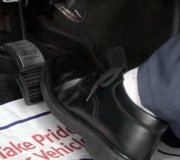Oops. From the description it sounds like air in the ABS unit. Here is the book version if that is the case. I have made the special tools, just a flat piece of sheet metal with a notch on one end, fold it over and drill a hole through it for the screw. I have even seen them made from small hinges with a spring to open them.
You can skip item eight if you get a good pedal, it simply resets the valving in the unit.
MANUAL BLEEDING:
The Electro-Hydraulic Control Unit Brake Pressure Modulator Valve Module (EHCU/BPMV) should be bled after replacement or if air is trapped in the unit or system. If system bleeding is required, the module must be bled thoroughly before the wheel cylinders and calipers.
There are two bleeders on top of the unit that appear to be normal bleeders. These are modulator bleeders and must remain closed when the unit is not pressurized.
The internal bleeders are on either side of EHCU/BPMV module. The valves are used to open the internal passages within the EHCU/BPMV module. Both bleed valves must be rotated 1/4 to 1/2 turn counterclockwise before beginning the bleed process. The valve on the lefthand side is used for the rear brakes and the valve on the righthand side is used for the front brakes.
NOTE: The ignition switch must be in the Off position or false diagnostic trouble codes may be stored.
SPECIAL TOOL REQUIRED (or equivalent)
* J-39177, Combination valve pressure bleeding tool (three required).
PROCEDURE
1. Install combination valve depressor tool J-39177 to LH high pressure accumulator bleed stem of EHCU/BPMV module.
2. Install combination valve depressor tool J-39177 to RH high pressure accumulator bleed stem of EHCU/BPMV module.
3. Install combination valve depressor tool J-39177 to rear combination valve.
4. Ensure master cylinder fluid level, fill if required.
5. Bleed EHCU/BPMV module as follows:
1. Slowly depress brake pedal one time and hold.
2. Open left modulator bleeder, until fluid flows clearly or pedal is depressed, the close left bleeder.
3. Slowly release brake pedal.
4. Wait 15 seconds, then repeat steps until all air is bled from EHCU/BPMV module.
5. Close LH internal bleed valve. Torque bleed valve to 7 Nm (5 ft lbs).
6. Repeat preceding bleed steps for righthand bleed procedure.
7. Remove special tools.
6. Ensure master cylinder fluid level, fill if required.
7. Bleed wheel cylinder and calipers.
8. Turn ignition key to On position, then perform 3 function test with TECH 1 scanner.
9. Check brake pedal feel and braking performance; repeat procedure if required.
Image (Click to make bigger)
Monday, April 10th, 2017 AT 4:49 AM





